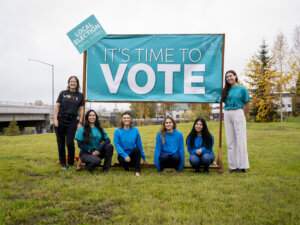 The importance of Indigenous voices in the electoral process cannot be overstated. As we approach the upcoming elections, it is crucial that we mobilize efforts to get out the native vote. Our rural communities face unique challenges that often go unheard, from land rights and environmental protection to health care and education.
The importance of Indigenous voices in the electoral process cannot be overstated. As we approach the upcoming elections, it is crucial that we mobilize efforts to get out the native vote. Our rural communities face unique challenges that often go unheard, from land rights and environmental protection to health care and education.
By exercising your right to vote, we can elect people that will advocate for policies that directly impact our lives and ensure that our concerns are prioritized.
This year, in addition to the Presidential election, there are many important statewide elections and ballot initiatives on Interior Alaskan ballots. We will fill a United States House of Representative seat, and at the statewide level, we will elect Senators, Representatives, and Judges.
Our elected officials are chosen to represent us, yet only 35% of our Interior residents take the time to vote. The act of voting is a powerful way to honor our heritage and shape the future for generations to come.
It is not just about casting a ballot; it is about standing up for the rights and issues that affect our communities most acutely. Every vote counts, and collectively, Indigenous voices can drive significant change in policy-making. Let us work together to ensure that every eligible Tribal citizen knows the importance of their vote and has the resources they need to participate fully in the democratic process.
This guide will help to inform you about the candidates and current ballot initiatives. It also arms you with all the information you need to register to vote, vote early, and know where your polling place is on Election Day. Make sure that you participate in the important process of using your vote as your voice!
Voter registration deadline: Sunday, October 6th
Check and update your registration: ALASKA – Online Voter Registration
Find your polling location: Polling Place Locations – Division of Elections (alaska.gov)
Early Voting Begins Monday, October 21st
Learn where you can early vote: Early and Absentee In-Person Voting Locations – Division of Elections (alaska.gov)
Ballot Measures
Ballot measure votes directly impact your daily life, and the daily lives of the people you care about. This year, there are two measures on the ballot.
Ballot Measure 1 is an initiative to increase Alaska’s minimum wage, provide workers with paid sick leave, and protect workers from practices that violate their constitutional rights.
Ballot Measure 2 is an act to get rid of the Open Primary System and Ranked-Choice General Election.
You can learn more about each ballot measure here: Petitions and Ballot Issues – Division of Elections (alaska.gov)
The Candidates
Learn more about your candidates: Candidates – Division of Elections (alaska.gov)
Legislative (House) Candidates by District
- 31: Maxine Dibert, Bart Lebon
- 32: Gary Damron, Will Stapp
- 33: Mike Prax
- 34: Joy Beth Cottle, Frank Tomaszewski
- 35: Ashley Carrick, Ruben McNeill Jr.
- 36: James Fields, Pamela Goode, Rebecca Schwanke, Brandon Kowalski
Senate Candidates by District
- P: Leslie Hajdukavich, Scott Kawasaki
- R: Mike Cronk, Savannah Fletcher, Robert Williams
Ranked Choice Voting
- Rank the candidates you like in order of preference.
- Your favorite is your first choice.
- Ranking other candidates doesn’t affect your first choice.
- If a candidate receives a majority of first-choice votes (50%+1), they win. If no candidate receives a majority, the candidate with the fewest votes is eliminated and voters that ranked that candidate first have their vote counted for their next choice.
- This process continues until one candidate receives a majority of voters’ choices.
Frequently Asked Questions About Ranked Choice Voting
Q: If I rank four candidates, does that mean I voted four times?
A: No. Only one vote counts per race. Your 2nd (or later) choice only matters if your 1st choice fails to get enough votes and is eliminated.
Q: What happens if there’s a tie?
A: It’s very unlikely that an RCV election will end in a tie. However, if there’s a tie at any step of the process, it will be decided the same as it has been in the past. Alaska law says the tie is resolved “by lot”, which means the division’s director will flip a coin or draw straws.
Q: What offices are elected using Ranked Choice Voting?
A: President/Vice President, U.S. Senators, U.S. Representative, Governor/Lieutenant Governor, and all state representatives and state senators. The open, pick 1 primary will be used for U.S. Senators, U.S. Representative, Governor/Lieutenant Governor, and all state representatives and state senators, but not for President/Vice President.
Learn more about ranked choice voting in the Genreral Election here: Election Information – Division of Elections (alaska.gov)
Interior Native Vote
Follow Interior Native Vote for election information, updates, and reminders: https://www.facebook.com/GOTNVinterior
